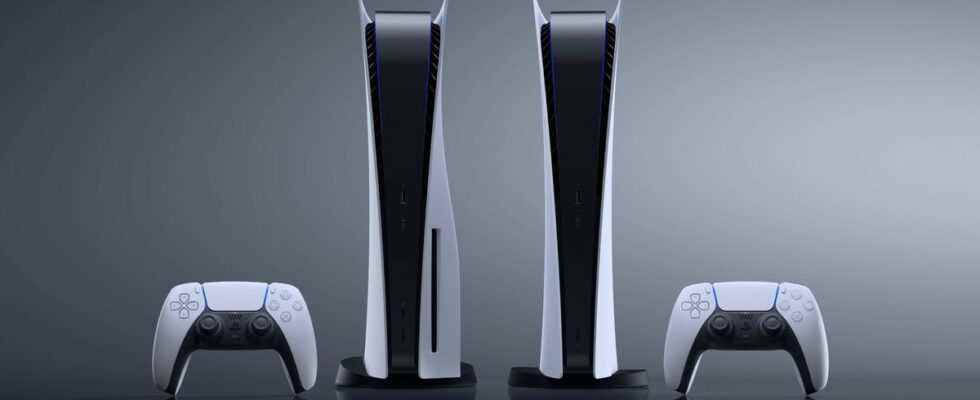4
Loudly requested by some gamers since the console’s launch, 1440p support on the PlayStation 5’s HDMI output is finally on the way, and even already available to system software beta testers.
Sony PlayStation 5 (PS5)

Note Digital


(4)
 Amazon
Amazon499.99
 baker.com
baker.com499.99
 Darty.com
Darty.com499.99
 Cdiscount
Cdiscount499.99
 Micromania
Micromania499.99
 Asgoodasnew.com
Asgoodasnew.com775.00
 Rakuten
Rakuten775.49
 Amazon Marketplace
Amazon Marketplace811.32
How the pricing table works
Sony PlayStation 5 (PS5) Digital Edition
Introductory price €399


Note Digital

 Amazon
Amazon399.99
 Fnac.com
Fnac.com399.99
 Cdiscount
Cdiscount399.99
 Cdiscount
Cdiscount399.99
 Micromania
Micromania399.99
How the pricing table works
It was about time, some would say. From July 28, Sony’s PlayStation 5 will receive the possibility of transmitting a video signal in 1440p on its HDMI output. This new format is in addition to the 720p, 1080i / p and 2160p (4K) already supported by the machine, through new system software deployed today in beta version. In doing so, Sony’s machine finally aligns not just with Microsoft’s Xbox Series X and S, but even the Xbox One S and One X, all of which have offered 1440p since they hit the market.
The 1440p is inserted between the 1080p and the 2160p, finally! ©Sony Interactive Entertainment
Release for PC monitors and 120Hz TVs but without HDMI 2.1
This news will certainly not fundamentally change the lives of all PS5 owners, far from it, but it still represents a real liberation for the players concerned. The first and most obvious use case is for a console connected to a PC monitor at 2560 x 1440 px, one of the most common screen definitions today. While some of these monitors are capable of receiving a 2160p signal as input and upscaling it themselves to their panel resolution, this is only a minority of them. With most models, the only signal definition allowed by both the PS5 and the monitor was 1080p, with the inevitable consequence of a final image that was less than ideal in sharpness. A problem that no longer arises.
Another situation to note is that of certain 4K televisions compatible with 120 Hz signals, but not HDMI 2.1 – this is the case in particular of many models of the 2018 and 2019 ranges from Samsung. Since they have to make do with the speeds of the HDMI 2.0 standard on their inputs, these televisions cannot receive a 2160p signal at 120 Hz, and in fact, the only way to access 120 Hz modes on the few compatible PS5 games was to switch to 1080p. But these same bit rates are on the other hand perfectly sufficient for a 1440p signal at 120 Hz, which therefore becomes a much more acceptable compromise. In particular, it gives a little meaning to these televisions with 40 fps display modes that we see appearing on more and more titles (and which require a 120 Hz signal to be displayed in a perfectly stable way ).
A little infidelity to HDMI specifications
The addition of this 1440p compatibility is, seemingly, a small revolution for PlayStation, which so far seemed to have the principle of always adhering as strictly as possible to the specifications defined by the HDMI Forum – specifications which, precisely, do not not provide the ability to carry a 1440p video stream. It’s this same extreme rigor that seems to explain why the PS5’s variable refresh rate feature strictly meets the HDMI VRR standard and no other, not even the AMD FreeSync standard from which it is derived.
Finally, it should be noted that we have been talking since the beginning of this article about the definition of the video signal sent via the HDMI output of the console, and not about the definition of internal rendering of games, which is completely decorrelated. There are already a myriad of PS5 games using 1440p as a target for their 3D rendering, with the resulting “source” image then simply upscaled by the console itself to 1080p or 2160p before being rendered. be sent to the display.
Other new features: folders for games and a comparison tool for 3D audio
The 1440p video output is not the only novelty brought by the new firmware of the PS5. The latter also introduces “game lists” that the user can use to organize the collection tab of their console interface. Files, in short, which will undoubtedly be very useful, especially for subscribers to the new Extra and Premium formulas of PlayStation Plus.
game lists ©Sony Interactive Entertainment
Finally, note in the sound settings, the appearance of a page on which the user can directly compare stereo audio and 3D audio when using a compatible sound device (headphones or TV speakers). This allows everyone to get a more concrete idea of the difference brought by the famous Tempest 3D AudioTech system of the console and to decide in full knowledge of the facts, if ever we do not find this convincing difference, to deactivate the processing. .
The new comparison page between 3D audio and stereo audio ©Sony Interactive Entertainment
The new system software is available now for those enrolled in the PS5 system software beta program. General availability will in all likelihood follow in the coming weeks.
